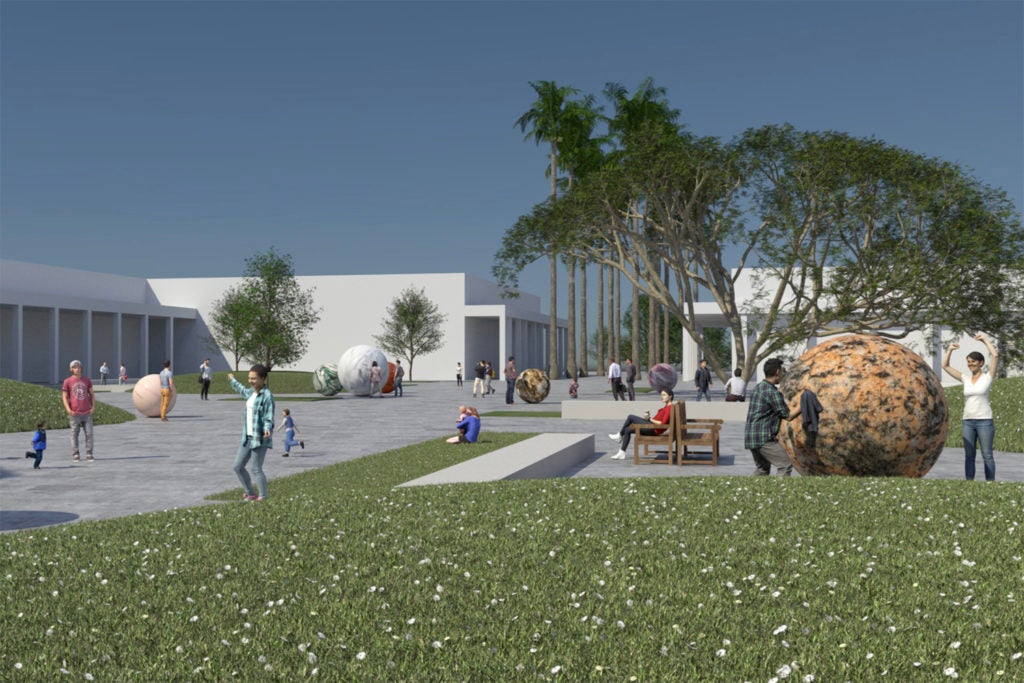Stanford’s Public Art Committee set to expand contemporary art offerings across campus
The university’s Public Art Committee oversees commissions of site-specific works by Alicja Kwade, Sam Van Aken, Xu Zhen.
The transformation of the arts at Stanford – begun a decade ago with the creation of the arts district – continues on, with transformative art installations in other locations on campus as well.

Rendering of Pars Pro Toto by Alicja Kwade. (Image credit: Courtesy Alicja Kwade, courtesy 303 Gallery, New York)
The Public Art Committee, chaired by Matthew Tiews, interim senior associate vice president for the arts and associate vice president for campus engagement, has been working with campus stakeholders to ensure that the public art program expands with purpose and thoughtful integration across the campus landscape. Upcoming additions include major installations in the Science and Engineering Quad (SEQ) and on Meyer Green, and a living work planted on the lawn between the Cantor Arts Center and the McMurtry Building.
The Public Art Committee was formed in 2019 to oversee implementation of a strategic plan for public art on the campus, including both outdoor art and art in public spaces of academic buildings and other campus facilities. The committee of 13, appointed by Stanford President Marc Tessier-Lavigne, includes faculty, students, staff and Stanford Board of Trustees representatives.
“The public art program at Stanford is a vital part of the academic mission of the university and it reflects the spirit and dynamism of life on campus,” Tiews said. “The committee’s first recommended commissions are works of the highest level of achievement and we expect them to foster connections across disciplines.”
In 2019, Stanford chose international artists Alicja Kwade and Xu Zhen to create site-specific outdoor works of art to be installed in 2020. Due to the pandemic, the installations were delayed a year, but both works are slated for installation in 2021. Kwade’s multi-piece work will be fully installed in the Science and Engineering Quad by March and Zhen’s work is anticipated to be installed between Green Library and Stanford Law School on Meyer Green this fall.
New York artist and educator Sam Van Aken was also chosen to install a work on campus in 2019: Tree of 40 Fruit, a sculpted-by-grafting tree, that will grow to produce 40 different varieties of native American stone fruit. While his installation was able to move forward without delay, and has been cared for during the campus closure, it will take several years for the work to be fully realized and bear its complete variety of fruit.
Polish-born Berlin-based Kwade created the first work of art for the SEQ artwork plan, which includes several works by different artists. The plan for art in SEQ was initiated by Jennifer Widom, dean of the School of Engineering, and developed in collaboration with SEQ stakeholders and the Public Art Committee. Kwade’s piece titled Pars Pro Toto consists of a dozen large-scale spheres of different sizes carved from stones from around the globe arranged in a seemingly haphazard way, as if a giant were throwing marbles on the quad. Kwade’s arrangement references the many-worlds interpretation of quantum mechanics that suggests that all possible alternative histories and futures are real, each representing an actual world or universe.
Zhen’s piece Hello is a towering Greek bronze column coiled to suggest the strike pose of a snake. The column, referencing the architecture of Stanford’s main quad, symbolizes the origin and cornerstone of Western civilization. It fuses together the classical Greek column shape and the snake’s aggressive biological attitude to stimulate viewers’ perceptions and experiences of classic civilization.
Hello is the first work in a new rotating public art series of temporary biennial commissions planned for Meyer Green called the Plinth Project. Modeled after the Fourth Plinth Project in London’s Trafalgar Square, the rotating nature of the Stanford Plinth Project will allow for greater innovation in the works selected and a stronger ability to reflect the current cultural moment, as well as more dynamic campus engagement opportunities.
All three of the new works were underwritten by private donors.
Other public works of art that have altered the Stanford landscape and have also been underwritten by private donors include OY/YO (2019) by artist Deborah Kass, acquired by the Cantor Arts Center and installed in front of the museum in 2019 in order to transform the traditional entrance; Buckyball (2019) by Leo Villareal, located at the entrance to the new Stanford Hospital in 2019 as part of Stanford Healthcare’s extensive indoor and outdoor artwork program; and MOCNA (2018) by Ursula von Rydingsvard, installed in front of Denning House, the home of the Knight-Hennessy Scholars Program, in 2018.
Kory Gaines, ’21, a member of the Public Art Committee, has a keen interest in public art and making all art forms as widely accessible to as many people as possible. Said Gaines: “Public art is important because it demands that we confront emotions that art pieces can bring up, and be in our own bodies, rather than our heads, when confronting such huge pieces of art.”